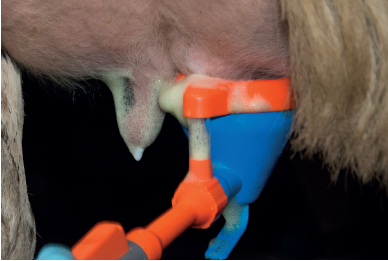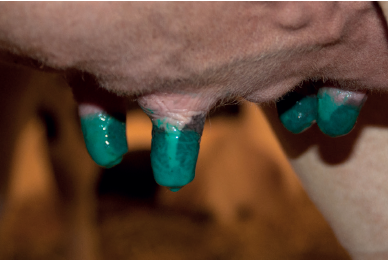Many pre and post udder hygiene products are available in the market place today: Iodine, chlorhexidine, lactic acid, chlorine dioxide. Concentrate form, RTU, 2 components? Spray, dip or film forming agent?
This article presents the key points to check in order to get the best hygiene protection on your farm before and after milking.
PRE MILKING: PROPER CLEANING OF THE COWS TEATS SETS THE BASIS OF SUCCESSFUL DISINFECTION
BEFORE MILKING, THE PRODUCT TO CHOOSE MUST HAVE EXCELLENT CLEANING AND FAST ACTING DISINFECTANT PROPERTIES:
Using a product with solely disinfecting activity is not recommended as the cows are coming into the parlor from aless than perfect environment in terms of hygiene. This is also aligned with the following principle: Clean first before you disinfect. Bacteria can hide underneath the dirt and other material covering the teat skin. Therefore they can remain not affected by the disinfectant. Dirt and organic material can also reduce the germ-killing ability of some disinfectants. Take iodophors or sodium hypochlorite for instance: a study has shown that they lose their disinfecting power in the presence of organic matter.
When it comes to skin (teat skin or hand skin) it is a rough surface, with cracks and creases. It is easy for bacteria to adhere and multiply. Applying disinfectant without cleaning first will not affect these bacteria, deeply imbedded in the creases and protected by a layer of dirt. A pre-milking disinfecting spray applied before milking will reduce the number of surfacelevel pathogens on the teats but not necessarily the bacteria that hide in the creases of the skin. What does remove these
imbedded pathogens is a proper teat cleaning method. The agitation created during the teat cleaning process dislodges the bacteria from the cracks and surfaces of the teats, enabling them to be removed when the teats are wiped off before the clusters are attached. A pre-milking foaming teat solution penetrates well in the cracks of the skin, therefore removing the imbedded bacteria.
IS A ONE-STEP CLEANING AND DISINFECTING PROCESS ACCEPTABLE?
Yes! Make sure the product has excellent cleaning properties and fast acting disinfectant, e.g. the fast antibacterial efficacy of lactic acid has been demonstrated in both anionic and nonionic surfactant-based cleaner formulations, at a concentration inferior to 3%, within 30 seconds contact time. The additional benefit of using a good teat cleaning agent before milking is that it keeps the teats cleaner in the long term as well.
HOW DO YOU RECOGNIZE A GOOD PRE-DIPPING CLEANING PRODUCT?
The result, of course, but also the foaming properties of the product. If the product foams well, and the foam is persistent (in the foaming cup) this is a good indication that it contains the effective ingredients to detach the dirt from the skin.
MILK SAFETY IS ALWAYS IMPORTANT
Pay particular attention to the possible residues that you can find in milk. Let’s take the example of iodine: it has been shown that iodine applied before or after milking (especially by spraying) increases the iodine content in milk. Thus extra precautions have to be taken, especially now that residues are more and more of a concern.
POST-MILKING TEAT DISINFECTION
Many options are available for post-milking disinfection in term of active substances as well as many forms of application, such as dipping or spraying, manually, semi-automated or fully automated.
HOW TO CHOOSE THE IDEAL SOLUTION FOR YOUR FARM?
TEAT CONDITION COMES FIRST
At CID LINES, we believe that soft skin and smooth teat end are the priority to prevent infections and bacteria growth. Teat end and teat skin are constantly solicited during the lactation: impact of the milking machine, important vacuum, versatile weather conditions, etc. That’s why the first question to answer before selecting a teat dip is: are the teat ends and the teat skin in a healthy condition? Dry skin and teat end showing hyperkeratosis crave for an extra teat conditioner. A product formulated 5,000ppm classical Iodine for instance, can not contain enough emollients to compensate the drying effect of the iodine present in the product. One should not forget that every chemical (every disinfectant) is toxic at a certain dose.
Therefore when the skin condition is under challenge, high emollient formulations, combined with a gentle disinfectant for the skin are highly recommended. Example: skin has a good tolerance for chlorhexidine based or lactic acid based teat dips.
CONSIDER THE VISCOSITY
The product viscosity has an impact on the duration of the contact between the skin and the product: the skin will benefit from an extended contact with a gentle and hydrating formulation, whereas it will suffer from an aggressive formulation.
As a consequence, a highly concentrated formulation based on a potentially irritative disinfectant molecule should be applied by spray (offering a shorter contact time). Film forming teat dips based on polymers is a third option, offering a physical barrier especially recommended in case of challenging environment: the dirt sticks on the film, not on the skin, it is then much easier to remove at the next milking.
WEATHER SPECIFIC FORMULATION
Specific weather conditions requires specific formulation: this is the case of winter conditions (temperature below zero degree Celsius and chilled wind). In this case, products that dry fast are more adapted (for instance, alcohol based formulation). What are the options when skin condition is of good quality? Oxidizing ingredient, such chlorine dioxide or iodine can be recommended to offer their large spectrum of activity, protecting against bacteria and also virus (responsible of warts) and algae (such as Prototheca).
DO NOT FORGET THE RISK OF RESIDUAL
If the teats are well prepared before milked, the risk of residues is negligible. As mentioned above, iodine formulation applied after milking by spraying has been associated to increased iodine content in the milk. Chlorine dioxide, present in the form of a solubilized gas, is less prone to residues in the milk.
To downlooad this article, click here.


